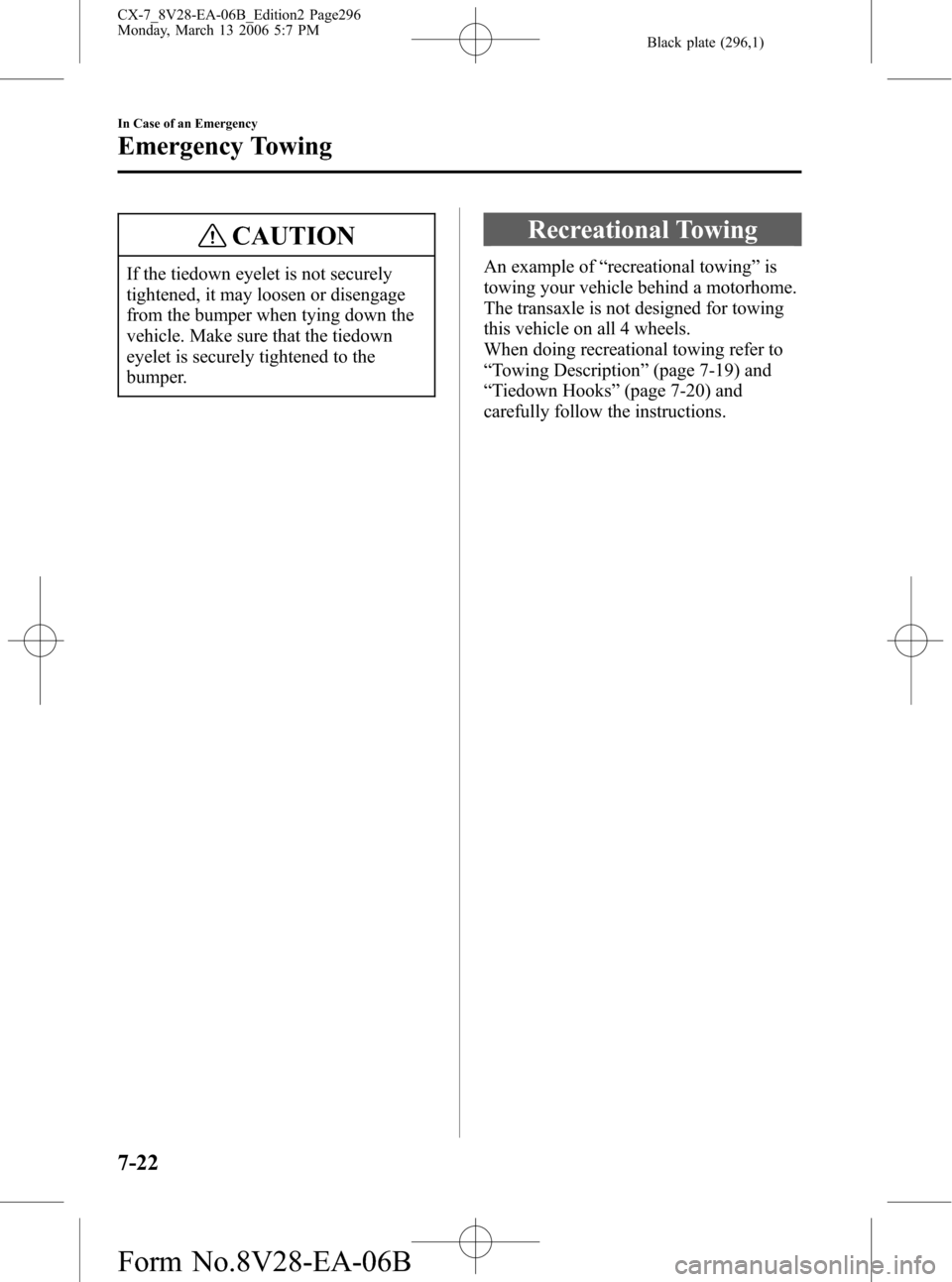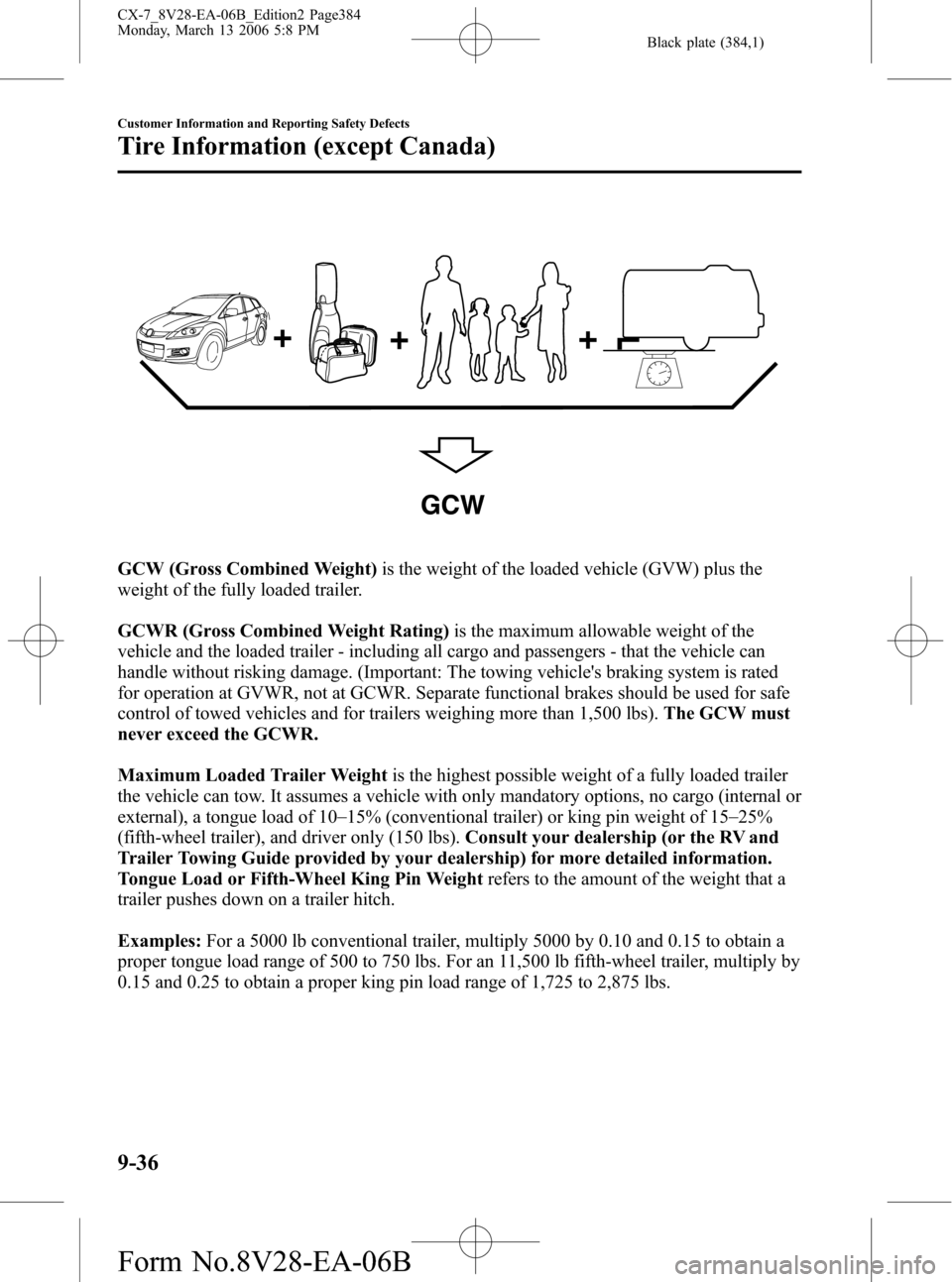towing MAZDA MODEL CX-7 2007 (in English) User Guide
[x] Cancel search | Manufacturer: MAZDA, Model Year: 2007, Model line: MODEL CX-7, Model: MAZDA MODEL CX-7 2007Pages: 406, PDF Size: 6.11 MB
Page 174 of 406

Black plate (174,1)
lMake sure to equip the vehicle with
genuine wheels of the specified size,
on all wheels. With AWD, the system
is calibrated for all four wheels being
of the same dimensions.
Tire chains
lInstall tire chains to the front tires.
lDo not drive the vehicle faster than 30
km/h (19 mph) with the tire chains
installed.
lDo not drive the vehicle with tire
chains on road conditions other than
snow or ice.
qTowing
If the vehicle requires towing, have it
towed with all four wheels completely off
the ground(page 7-19).
Cruise Control
With cruise control, you can set and
automatically maintain any speed of more
than about 30 km/h (19 mph).
WARNING
Do not use the cruise control under
the following conditions:
Using the cruise control under the
following conditions is dangerous and
could result in loss of vehicle control.
lHilly terrainlSteep inclineslHeavy or unsteady trafficlSlippery or winding roadslSimilar restrictions that require
inconsistent speed
qCruise Main Indicator Light
(Amber)/Cruise Set Indicator
Light (Green)
The indicator light has two colors.
Cruise Main Indicator Light (Amber)
The indicator light illuminates amber
when the ON/OFF switch is pressed and
the cruise control system is activated.
Cruise Set Indicator Light (Green)
The indicator light illuminates green when
a cruising speed has been set.
5-18
Driving Your Mazda
Starting and Driving
CX-7_8V28-EA-06B_Edition2 Page174
Monday, March 13 2006 5:6 PM
Form No.8V28-EA-06B
Page 275 of 406

Black plate (275,1)
7In Case of an Emergency
Helpful information on what to do in an emergency.
Parking in an Emergency ............................................................. 7-2
Parking in an Emergency .......................................................... 7-2
Flat Tire ......................................................................................... 7-3
Spare Tire and Tool Storage ...................................................... 7-3
Changing a Flat Tire ................................................................. 7-6
Overheating ................................................................................. 7-12
Overheating ............................................................................. 7-12
Emergency Starting .................................................................... 7-14
Starting a Flooded Engine ....................................................... 7-14
Jump-Starting .......................................................................... 7-15
Push-Starting ........................................................................... 7-18
Emergency Towing ..................................................................... 7-19
Towing Description ................................................................. 7-19
Tiedown Hooks ....................................................................... 7-20
Recreational Towing ............................................................... 7-22
7-1
CX-7_8V28-EA-06B_Edition2 Page275
Monday, March 13 2006 5:7 PM
Form No.8V28-EA-06B
Page 293 of 406

Black plate (293,1)
Towing Description
We recommend that towing be done only
by an Authorized Mazda Dealer or a
commercial tow-truck service.
Proper lifting and towing are necessary to
prevent damage to the vehicle.
Particularly when towing a AWD vehicle,
where all the wheels are connected to the
drive train, proper transporting of the
vehicle is absolutely essential to avoid
damaging the drive system. Government
and local laws must be followed.
Wheel dollies
A towed 2WD vehicle should have its
front wheels off the ground. If excessive
damage or other conditions prevent this,
use wheel dollies.
When towing a 2WD vehicle with the rear
wheels on the ground, release the parking
brake.
A towed AWD vehicle must have all its
wheels off the ground.
CAUTION
Don't tow the vehicle pointed backward
with driving wheels on the ground. This
may cause internal damage to the
transaxle.
CAUTION
Don't tow with sling-type equipment.
This could damage your vehicle. Use
wheel-lift or flatbed equipment.
In Case of an Emergency
Emergency Towing
7-19
CX-7_8V28-EA-06B_Edition2 Page293
Monday, March 13 2006 5:7 PM
Form No.8V28-EA-06B
Page 294 of 406

Black plate (294,1)
WARNING
Towing a AWD Vehicle:
Towing a AWD vehicle with either the
front or rear wheels on the ground is
dangerous as the drive train could be
damaged, or the vehicle could trail
away from the tow truck and cause an
accident. Always tow a AWD vehicle
with all four wheels off the ground. If
the drive train has been damaged,
transport the vehicle on a flat bed
truck.
Tiedown Hooks
CAUTION
Don't use the tiedown hooks under the
front and rear for towing.
They are designed ONLY for tying
down the vehicle when it's being
transported. Using them for towing will
damage the bumper.
qTiedown Hooks
1. Remove the tiedown eyelet, lug
wrench, and jack lever from the trunk
(page 7-3).
2. Wrap the jack lever with a soft cloth to
prevent damage to the bumper and
open the cap located on the front and
rear bumper.
7-20
In Case of an Emergency
Emergency Towing
CX-7_8V28-EA-06B_Edition2 Page294
Monday, March 13 2006 5:7 PM
Form No.8V28-EA-06B
Page 295 of 406

Black plate (295,1)
CAUTION
The cap cannot be completely removed.
Do not use excessive force as it may
damage the cap or scratch the painted
bumper surface.
3. Securely install the tiedown eyelet
using the lug wrench.
Lug wrench
Lug wrench
4. Hook the tying rope to the tiedown
eyelet.
In Case of an Emergency
Emergency Towing
7-21
CX-7_8V28-EA-06B_Edition2 Page295
Monday, March 13 2006 5:7 PM
Form No.8V28-EA-06B
Page 296 of 406

Black plate (296,1)
CAUTION
If the tiedown eyelet is not securely
tightened, it may loosen or disengage
from the bumper when tying down the
vehicle. Make sure that the tiedown
eyelet is securely tightened to the
bumper.
Recreational Towing
An example of“recreational towing”is
towing your vehicle behind a motorhome.
The transaxle is not designed for towing
this vehicle on all 4 wheels.
When doing recreational towing refer to
“Towing Description”(page 7-19) and
“Tiedown Hooks”(page 7-20) and
carefully follow the instructions.
7-22
In Case of an Emergency
Emergency Towing
CX-7_8V28-EA-06B_Edition2 Page296
Monday, March 13 2006 5:7 PM
Form No.8V28-EA-06B
Page 301 of 406

Black plate (301,1)
Maintenance IntervalNumber of months or kilometers (miles), whichever comes first
Months 6 12 18 24 30 36 42 48
×1000 km 12 24 36 48 60 72 84 96
×1000 miles 7.5 15 22.5 30 37.5 45 52.5 60
AIR CONDITIONER SYSTEM (if equipped)
Cabin air filter Replace every 40,000 km (25,000 miles) or 2 years
Chart symbols:
I:Inspect and repair, clean, adjust, or replace if necessary.
R:Replace
L:Lubricate
Remarks:
*1 Use FL22 type coolant in vehicles with the inscription“FL22”on the radiator cap itself or the surrounding
area. Use FL22 when replacing the coolant.
*2 According to state/provincial and federal regulations, failure to perform maintenance on these items will not
void your emissions warranties. However, Mazda recommends that all maintenance services be performed at
the recommended time or mileage/kilometer period to ensure long-term reliability.
*3 If the vehicle is operated primarily under any of the following conditions, replace the rear differential oil every
45,000 km (28,100 miles).
a) Towing a trailer or using a car-top carrier
b) Driving in dusty, sandy or wet condition
c) Extended periods of idling or low-speed operation
d) Repeated short trips of less than 16 km (10 miles)
*4 If this component has been submerged in water, the oil should be replaced.
Maintenance and Care
Scheduled Maintenance
8-5
CX-7_8V28-EA-06B_Edition2 Page301
Monday, March 13 2006 5:7 PM
Form No.8V28-EA-06B
Page 303 of 406

Black plate (303,1)
Maintenance IntervalNumber of months or kilometers (miles), whichever comes first
Months 4 8 12 16 20 24 28 32 36 40 44 48
×1000 km 8 16 24 32 40 48 56 64 72 80 88 96
×1000 miles 5 10 15 20 25 30 35 40 45 50 55 60
CHASSIS and BODY
Brake lines, hoses and connections I I
Brake fluid levelIIIIIIIIIIII
Disc brakesIIII
Tire (Rotation) Rotate every 8,000 km (5,000 miles)
Tire inflation pressure and tire wearIIIIIIIIIIII
Steering operation and linkages I I
Power steering fluid levelIIIIIIIIIIII
Front and rear suspension and ball joints I I
Rear differential oil
*4*5
Transfer oil*5
Driveshaft dust boots I I
Exhaust system and heat shields Inspect every 72,000 km (45,000 miles) or 5 years
All locks and hingesLLLLLLLLLLLL
Washer fluid levelIIIIIIIIIIII
AIR CONDITIONER SYSTEM (if equipped)
Cabin air filter Replace every 40,000 km (25,000 miles) or 2 years
Chart symbols:
I:Inspect and repair, clean, adjust, or replace if necessary.
R:Replace
L:Lubricate
Remarks:
*1 Use FL22 type coolant in vehicles with the inscription“FL22”on the radiator cap itself or the surrounding
area. Use FL22 when replacing the coolant.
*2 According to state/provincial and federal regulations, failure to perform maintenance on these items will not
void your emissions warranties. However, Mazda recommends that all maintenance services be performed at
the recommended time or mileage/kilometer period to ensure long-term reliability.
*3 If the vehicle is operated primarily under any of the following conditions, replace the spark plugs every 96,000
km (60,000 miles) or shorter.
a) Repeated short-distance driving
b) Extended periods of idling or low-speed operation
c) Driving for long periods in cold temperatures or extremely humid climates
*4 If the vehicle is operated primarily under any of the following conditions, replace the rear differential oil every
45,000 km (28,100 miles).
a) Towing a trailer or using a car-top carrier
b) Driving in dusty, sandy or wet condition
c) Extended periods of idling or low-speed operation
d) Repeated short trips of less than 16 km (10 miles)
*5 If this component has been submerged in water, the oil should be replaced.
Maintenance and Care
Scheduled Maintenance
8-7
CX-7_8V28-EA-06B_Edition2 Page303
Monday, March 13 2006 5:7 PM
Form No.8V28-EA-06B
Page 381 of 406

Black plate (381,1)
SAMPLE
CARGO
Cargo Weightincludes all weight added to the Base Curb Weight, including cargo and
optional equipment. When towing, trailer tongue load or king pin weight is also part of
cargo weight.
The cargo weight limit decreases depending on the number of vehicle occupants. The cargo
weight limit can be calculated by subtracting the total weight of the vehicle occupants from
the“combined weight of occupants and cargo should never exceed”value on the tire label.
Customer Information and Reporting Safety Defects
Tire Information (except Canada)
9-33
CX-7_8V28-EA-06B_Edition2 Page381
Monday, March 13 2006 5:8 PM
Form No.8V28-EA-06B
Page 384 of 406

Black plate (384,1)
GCW
GCW (Gross Combined Weight)is the weight of the loaded vehicle (GVW) plus the
weight of the fully loaded trailer.
GCWR (Gross Combined Weight Rating)is the maximum allowable weight of the
vehicle and the loaded trailer - including all cargo and passengers - that the vehicle can
handle without risking damage. (Important: The towing vehicle's braking system is rated
for operation at GVWR, not at GCWR. Separate functional brakes should be used for safe
control of towed vehicles and for trailers weighing more than 1,500 lbs).The GCW must
never exceed the GCWR.
Maximum Loaded Trailer Weightis the highest possible weight of a fully loaded trailer
the vehicle can tow. It assumes a vehicle with only mandatory options, no cargo (internal or
external), a tongue load of 10_
15% (conventional trailer) or king pin weight of 15_
25%
(fifth-wheel trailer), and driver only (150 lbs).Consult your dealership (or the RV and
Trailer Towing Guide provided by your dealership) for more detailed information.
Tongue Load or Fifth-Wheel King Pin Weightrefers to the amount of the weight that a
trailer pushes down on a trailer hitch.
Examples:For a 5000 lb conventional trailer, multiply 5000 by 0.10 and 0.15 to obtain a
proper tongue load range of 500 to 750 lbs. For an 11,500 lb fifth-wheel trailer, multiply by
0.15 and 0.25 to obtain a proper king pin load range of 1,725 to 2,875 lbs.
9-36
Customer Information and Reporting Safety Defects
Tire Information (except Canada)
CX-7_8V28-EA-06B_Edition2 Page384
Monday, March 13 2006 5:8 PM
Form No.8V28-EA-06B